Glojas Aesthetic Clinic | Vanquish Fat Reduction

The video “Glojas Aesthetic Clinic – Vanquish Fat Reduction with Miss Universe Finalist Keshinie Siva” showcases Keshinie Siva visiting Glojas Specialist Clinic for a Vanquish fat reduction treatment. The clinic staff explains that the procedure uses selective radio frequency to target fat tissue. Keshinie describes the treatment as slightly uncomfortable but with noticeable results, particularly a flatter stomach after the session. She expresses satisfaction with the overall experience and outcome. Glojas Aesthetic Clinic | Get ready to be inspired! Watch as Miss Universe finalist Keshinie Siva shares her journey to achieving a sculpted body with Vanquish Fat Reduction at GLOJAS Specialist Clinic. Discover how Vanquish technology works and why it’s the non-invasive solution for stubborn fat. Learn about Keshinie’s experience, her results, and her tips for maintaining a healthy lifestyle. Don’t miss this opportunity to see how Vanquish can help you achieve your body goals. Like, share, and subscribe for more health and beauty content! #aestheticsclinickl #skincaresolutions #skincaretips #skin #skincare #skincaretips #acné #acne #acnetips #acnescars #acneproblems #acnetreatment #acneproneskin #acnechallenge #acnecommunity #AntiAging #antiaging #antiagingtips #antiagingserum #antiagingskincare #antiagingproducts #antiagingtreatment #antiagingserum #antiagingcream #antiaginghaircare #AntiAgingSolutions #antiagingtreatment
Breast Surgery Guide: Lift or Augmentation Is The Best with Dr. Muya
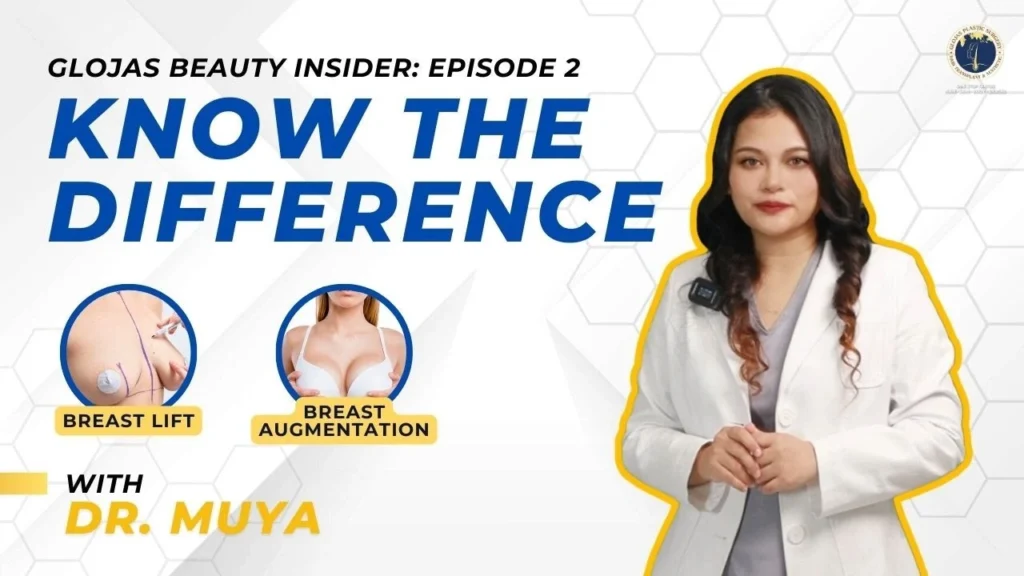
The video “Breast Surgery Guide: Lift or Augmentation with Dr. Muya l GLOJAS BEAUTY INSIDER” explores the difference between breast lift (mastopexy) and breast augmentation. Dr. Muya explains that a breast lift reshapes and lifts sagging breasts, giving them a more youthful appearance, while breast augmentation increases breast size using implants or fat transfer. The video aims to help viewers understand these options and make an informed decision aligned with their aesthetic goals. Welcome to EP: 02 of the GLOJAS BEAUTY INSIDER series! In this episode, Dr. Muya dives into the world of breast surgery, focusing on the key differences between a breast lift and breast augmentation. Discover the benefits, potential risks, and recovery times associated with each procedure. Tune in to make an informed decision about your breast surgery options. Don’t miss out on expert advice and tips from Dr. Muya! What is plastic surgery? Plastic surgery is a specialized branch of surgery that involves the reconstruction, alteration, or restoration of the human body. It can be broadly categorized into reconstructive surgery, which aims to restore function and appearance following injury or illness, and cosmetic surgery, which focuses on enhancing the aesthetic appeal of various body parts. Common procedures include breast surgery, rhinoplasty, liposuction, and facelifts. Plastic surgery combines medical expertise with artistic skill to improve patients’ quality of life and self-confidence.
Hair Transplant in Malaysia | Best Results & Cost of Hair Transplant in Malaysia
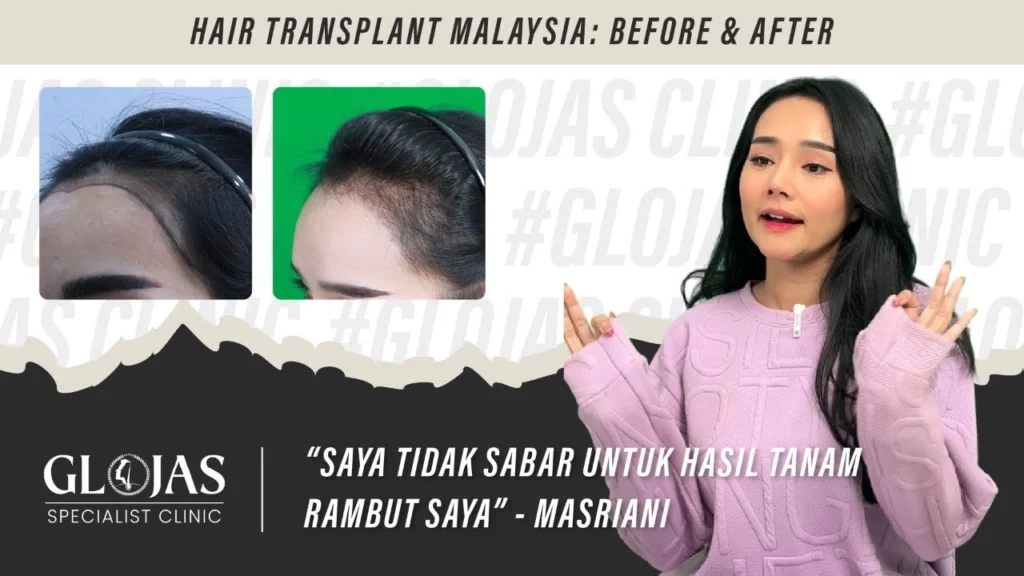
The video titled “Hair Transplant in Malaysia: Best Results & Cost of Hair Transplant in Malaysia“ focuses on hair transplant treatments and their outcomes. It briefly discusses patient experiences and the effectiveness of the procedures offered in Malaysia. The video emphasizes positive results and recommends the clinic for those seeking hair restoration services. Masriani shares her experience after undergoing a hair transplant procedure at GLOJAS Specialist Clinic. In this video, Masriani will showcase the results of her hair after 3 months of treatment. She will also discuss the treatment process, her experience at the clinic, and the changes she has noticed in her hair. If you’re looking for the best Plastic Surgery, Hair Transplant, and Aesthetic Clinic in Malaysia, we are here to help you. #hairtransplantmalaysia
Aesthetic Clinic Kuala Lumpur, Malaysia | Hair Rejuvenation and Body Contouring
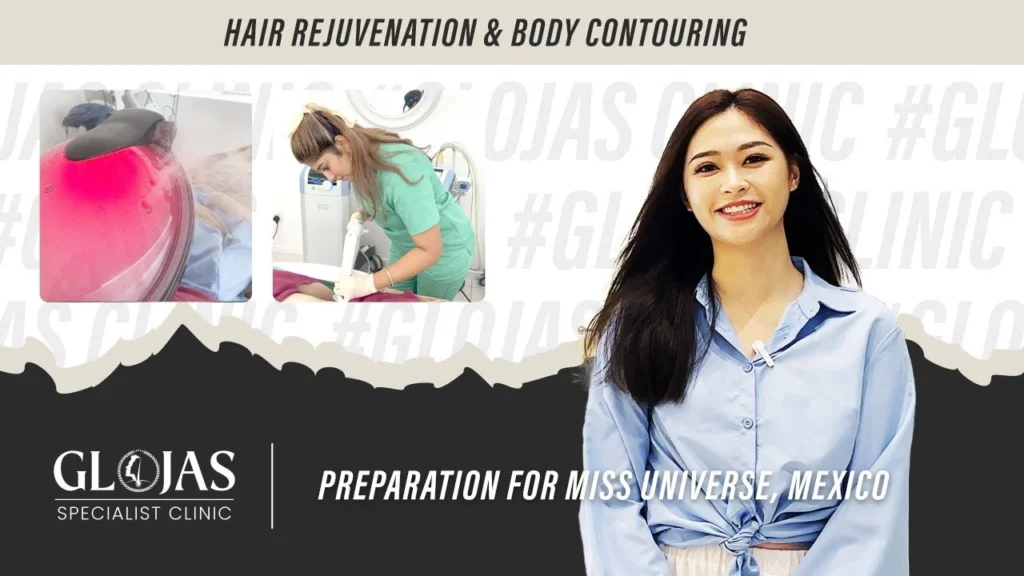
The video “Glojas Aesthetic Clinic Kuala Lumpur, Malaysia: Hair Rejuvenation and Body Contouring” features Miss Universe Malaysia 2024, Sandra Lim, preparing for the Miss Universe competition in Mexico. At Glojas Specialist Clinic, she consults with Dr. Venu and undergoes treatments for hair rejuvenation and body contouring. The video details two treatments: ozone hair therapy to improve blood circulation and eliminate scalp infections, and jet massage to nourish hair follicles. The body contouring procedure focuses on skin tightening, cellulite reduction, and body shaping, leaving Sandra satisfied with the results. Glojas Aesthetic Clinic Kuala Lumpur, Malaysia | Miss Universe Malaysia 2024, Sandra Lim’s Transformation: Hair Rejuvenation and Body Contouring at GLOJAS. Sandra Lim, Miss Universe Malaysia 2024, a stunning beauty and role model, shares her incredible transformation with GLOJAS Specialist Clinic. In this video, Sandra reveals how she achieved her dream body and radiant hair with GLOJAS’s expert hair rejuvenation and body contouring treatments. Discover the life-changing results Sandra experienced and learn about the innovative techniques used at GLOJAS to help you achieve your desired look. If you are looking for best Plastic Surgery, Hair Transplant and Aesthetic Clinic in Malaysia we will be happy to serve you. ✅ Best Plastic Surgery, Hair Transplant and Aesthetic Clinic In Malaysia With Over 26 Years Of Experience ✅ 100,000+ Successful Cases ✅ Resolved 20,000+ Failed Hair Transplant Cases ✅ Recognized as the Best SME Clinic in Malaysia for Hair Transplant & Aesthetic Treatments
Top-Rated Hair Doctor in Malaysia: Why Prof. Dato’ JasG is Your Best Choice
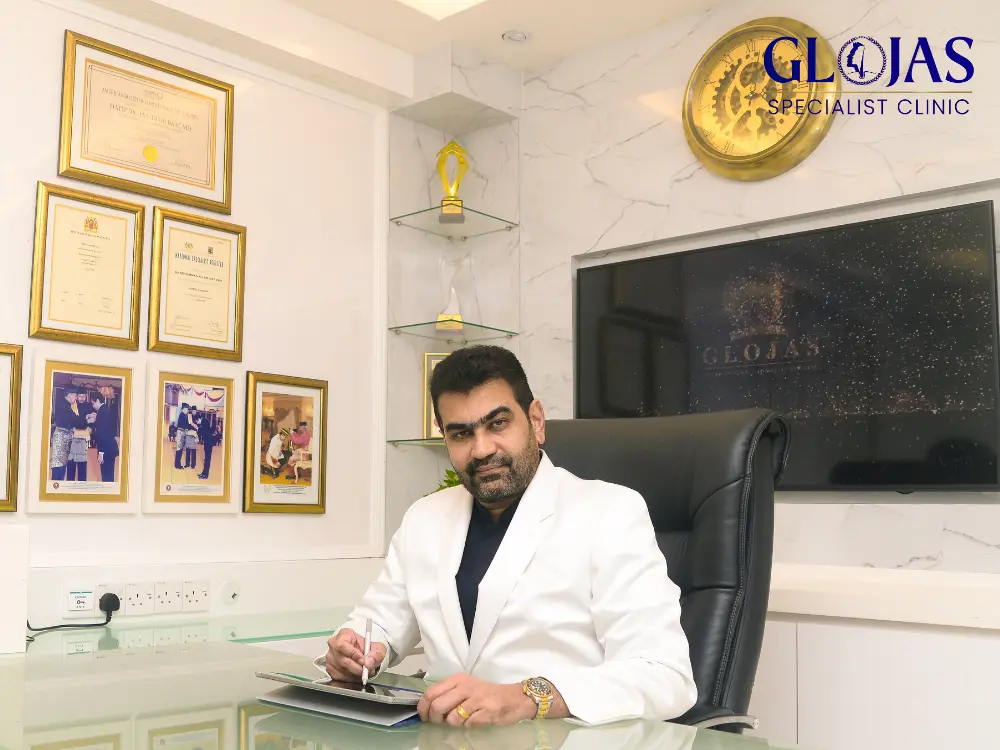
When it comes to finding a hair doctor Malaysia, choosing the right professional is crucial. Hair loss and other scalp-related issues can have a significant impact on your confidence and overall well-being. In Malaysia, one name stands out for his expertise, experience, and dedication to hair restoration: Prof. Dato’ JasG. With distinguished qualifications from ABHRS (American Board of Hair Restoration Surgery) and IHRS (International Society of Hair Restoration Surgery), Prof. Dato’ JasG is a trusted and top-rated hair doctor in Malaysia, offering advanced solutions for a variety of hair and scalp conditions. The Expertise of Prof. Dato’ JasG: Leading Hair Doctor Prof. Dato’ JasG is renowned in Malaysia and internationally as a leading expert in hair restoration and trichology. His deep understanding of hair health, coupled with years of hands-on experience, makes him the go-to hair doctor Malaysia for those struggling with hair loss, thinning hair, and scalp issues. Prof. Dato’ JasG’s Impressive Qualifications One of the key reasons behind Prof. Dato’ JasG’s reputation as a top hair doctor Malaysia is his prestigious qualifications. He is certified by the American Board of Hair Restoration Surgery (ABHRS), a credential that reflects his high level of expertise in hair transplantation and restoration. Additionally, he is a member of the International Society of Hair Restoration Surgery (ISHRS), which further solidifies his standing as a leading professional in the field. These qualifications are not just titles; they represent years of dedicated study, practice, and a commitment to staying at the forefront of hair restoration techniques and technologies. For anyone seeking a hair doctor Malaysia with proven expertise, Prof. Dato’ JasG’s credentials provide assurance of the highest standards of care. Comprehensive Hair Treatments by the Best Hair Doctor Malaysia Prof. Dato’ JasG offers a wide range of treatments, tailored to address the unique needs of each patient. Whether you’re dealing with male or female pattern baldness, alopecia, or other scalp conditions, his clinic provides cutting-edge solutions that are both effective and safe. Hair Transplantation One of the most sought-after treatments offered by this top hair doctor Malaysia is hair transplantation. Prof. Dato’ JasG specializes in Follicular Unit Extraction (FUE) and Follicular Unit Transplantation (FUT), two of the most advanced techniques available today. These procedures involve transplanting individual hair follicles from a donor area to the balding or thinning areas, ensuring natural-looking results with minimal scarring. Scalp Micropigmentation For those who may not be candidates for a hair transplant or prefer a non-surgical option, scalp micropigmentation is another service offered by Prof. Dato’ JasG. This technique involves tattooing small dots on the scalp to mimic the appearance of hair follicles, creating the illusion of a fuller head of hair. It’s an excellent option for individuals with thinning hair or those who want to enhance the results of a hair transplant. PRP Therapy for Hair Loss Platelet-Rich Plasma (PRP) therapy is another innovative treatment available at Prof. Dato’ JasG’s clinic. PRP therapy involves using the patient’s own blood, which is processed to concentrate the platelets and then injected into the scalp. This stimulates hair growth and can be used in conjunction with other treatments like hair transplantation for enhanced results. As a leading hair doctor in Malaysia, Prof. Dato’ JasG has extensive experience in administering PRP therapy, making it a safe and effective option for many patients. Personalized Care at the Leading Hair Clinic in Malaysia What truly sets Prof. Dato’ JasG apart as a hair doctor Malaysia is his approach to personalized care. Every patient is unique, and so are their hair restoration needs. Prof. Dato’ JasG takes the time to understand each patient’s concerns, expectations, and goals before recommending a treatment plan. This tailored approach ensures that every patient receives the most appropriate and effective treatment for their specific condition. Consultation and Diagnosis The first step in any treatment plan is a thorough consultation and diagnosis. Prof. Dato’ JasG uses advanced diagnostic tools and techniques to assess the extent of hair loss and identify the underlying causes. This comprehensive evaluation is critical to developing a treatment plan that will deliver the best possible results. Aftercare and Follow-Up Aftercare is just as important as the treatment itself. Prof. Dato’ JasG’s clinic provides detailed aftercare instructions to ensure that patients recover well and achieve optimal results. Regular follow-up appointments are also scheduled to monitor progress and make any necessary adjustments to the treatment plan. Why Choose Prof. Dato’ JasG as Your Hair Doctor Malaysia? There are many reasons why Prof. Dato’ JasG is considered the best hair doctor Malaysia. His impressive qualifications, extensive experience, and commitment to patient care make him the top choice for anyone seeking hair restoration services. Whether you are experiencing early signs of hair loss or have been struggling with baldness for years, Prof. Dato’ JasG offers the expertise and personalized care you need to regain your confidence. State-of-the-Art Clinic Prof. Dato’ JasG’s clinic is equipped with the latest technology and facilities, ensuring that patients receive the highest standard of care in a comfortable and professional environment. The clinic’s team is trained to provide exceptional support, making every visit a positive experience. Patient Testimonials The success stories of countless patients are a testament to Prof. Dato’ JasG’s skill and dedication. Many have shared their experiences of how he helped them overcome hair loss and regain their confidence. These testimonials highlight not only the effectiveness of the treatments but also the compassionate care that Prof. Dato’ JasG and his team provide. Frequently Asked Questions What makes Prof. Dato’ JasG the best hair doctor Malaysia? Prof. Dato’ JasG is widely regarded as the best hair doctor in Malaysia due to his extensive qualifications, including certifications from the ABHS and IHRS, as well as his personalized approach to patient care. What treatments does Prof. Dato’ JasG offer for hair loss? Prof. Dato’ JasG offers a range of treatments, including hair transplantation (FUE and FUT), scalp micropigmentation, and PRP therapy, all tailored to meet the individual needs of his patients. Is hair transplantation
Hair Transplant Malaysia | Pakar Tanam Rambut | Best Results & Cost | Testimonials
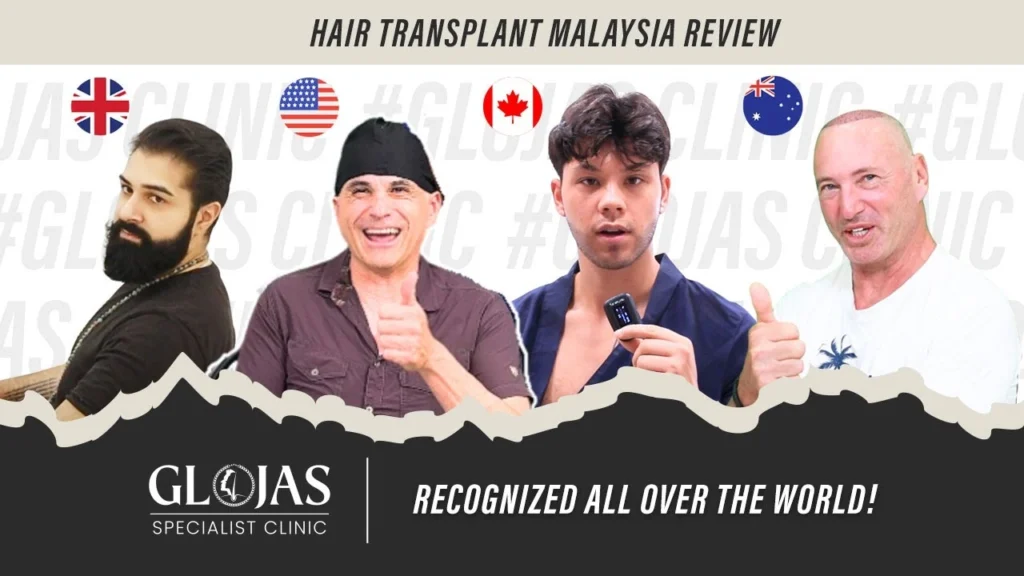
The video titled *”Hair Transplant in Malaysia: Best Results & Cost of Hair Transplant in Malaysia – Testimonials”* features international patients from various countries, including the UK, Japan, Canada, and Australia, who traveled to Malaysia for hair transplant treatment at Glojas Clinic. They share their positive experiences with the SMART FUE procedure, expressing satisfaction with the results and recommending the clinic for hair restoration services. The video highlights the clinic’s professionalism and the high-quality care provided to patients from around the world. #hairtransplant #hairtransplantation #hairtransplantsurgery #hairtransplants #HairTransplantResults #Hairtransplantrecovery #hairrestoration #fue #hairrestorationclinic #HairRestorationSurgery #HairRestorationExperts #HairRestorationJourney #hairrestorationsurgeon #hairrestorationsurgery #hairrestorationspecialist #hairrestorationspecialist #hairrestorationtreatments “
Hair Transplant Malaysia | Pakar Tanam Rambut | Moustache Hair Transplant for Cleft Palate

The video titled *”Hair Transplant Malaysia – Moustache Hair Transplant for Cleft Palate”* features a patient born with a cleft palate who seeks a moustache hair transplant at Glojas Specialist. The procedure uses the SMART FUE technique to extract hair grafts and implant them into the patient’s moustache area. The video shows the steps of the procedure, with the patient expressing satisfaction afterward. The patient also shares their gratitude to Glojas for providing the service, encouraging others with similar conditions to consider the treatment. Moustache Hair Transplant for Cleft Palate: A Life-Changing Procedure GLOJAS Specialist Clinic is proud to share this heartwarming story of a cleft palate patient who received a life-changing moustache hair transplant. Watch as the patient’s confidence and self-esteem are restored, thanks to our innovative hair transplant techniques. Learn about the procedure, recovery process, and the incredible results achieved. Don’t miss this inspiring video! Like, share, and subscribe for more hair transplant success stories and updates from GLOJAS. #hairtransplant #hairtransplantation #hairtransplantsurgery #hairtransplants #HairTransplantResults #Hairtransplantrecovery #hairrestoration #fue #hairrestorationclinic #HairRestorationSurgery #HairRestorationExperts #HairRestorationJourney #hairrestorationsurgeon #hairrestorationsurgery #hairrestorationspecialist #hairrestorationspecialist #hairrestorationtreatments
7 Surprising Facts About Melanin and How Fractional CO2 Laser Affects It
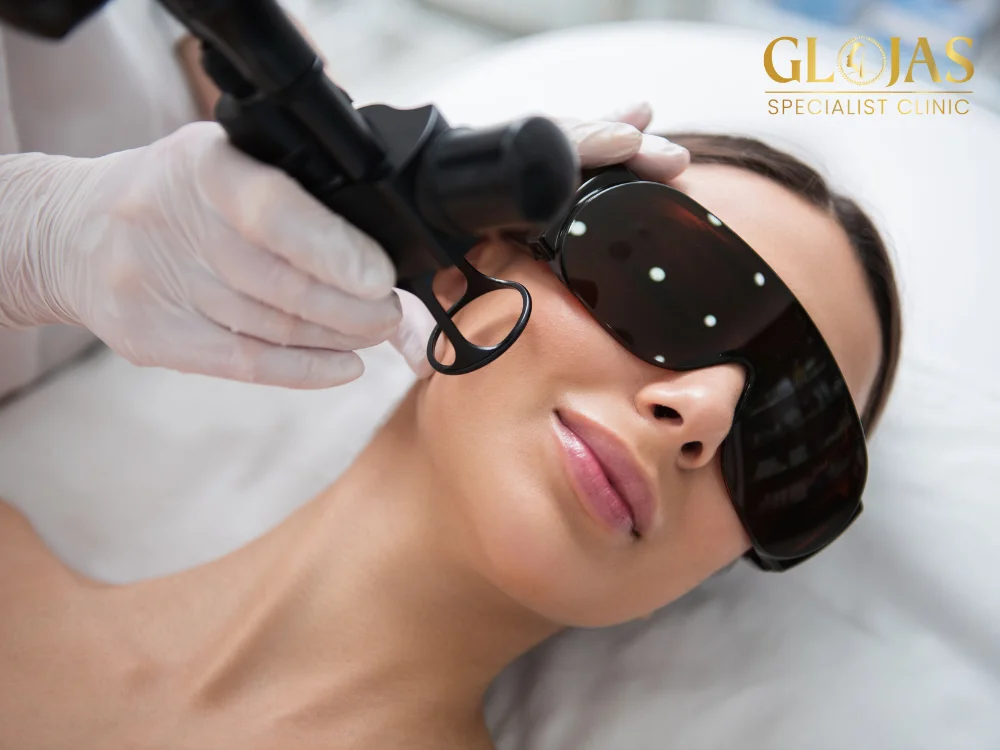
Melanin is a crucial component of our skin, playing a significant role in determining skin color and protecting us from the harmful effects of UV radiation. However, melanin is not just about skin tone; it also affects various aspects of our health and appearance. In recent years, cosmetic procedures like the Fractional CO2 Laser have gained popularity for their ability to treat skin imperfections, but how do they interact with melanin? This article explores the fascinating world of melanin and the impact of fractional CO2 laser treatments on this vital pigment. What Is Melanin? Melanin is a natural pigment found in the skin, hair, and eyes of humans and other animals. It is produced by cells called melanocytes, which are located in the bottom layer of the skin’s epidermis. Melanin is responsible for the color of our skin, hair, and eyes, and it plays a protective role by absorbing harmful ultraviolet (UV) radiation from the sun. Types of Melanin There are three primary types of melanin, each contributing to different skin tones and hair colors: Eumelanin: This type of melanin is found in two forms, black and brown. Eumelanin is the most common form of melanin and is responsible for dark hair and skin. Pheomelanin: Pheomelanin is responsible for red hair and is found in smaller amounts in the skin. It provides a pinkish hue and is less effective at protecting the skin from UV radiation. Neuromelanin: This type of melanin is found in the brain and is involved in the regulation of neural functions. Unlike eumelanin and pheomelanin, neuromelanin does not contribute to skin or hair color. The Role of Melanin in Skin Protection Melanin’s primary function is to protect the skin from UV radiation. When the skin is exposed to the sun, melanocytes produce more melanin, which absorbs and dissipates the harmful rays. This process is what causes tanning. However, excessive sun exposure can lead to overproduction of melanin, resulting in hyperpigmentation, age spots, and an uneven skin tone. 7 Surprising Facts About Melanin Melanin is a complex and fascinating substance with many roles beyond just determining skin color. Here are seven surprising facts about melanin that you might not know: 1. Melanin Protects Against UV Damage Melanin acts as a natural sunscreen by absorbing up to 75% of UV radiation. This absorption helps prevent DNA damage in skin cells, reducing the risk of skin cancer. However, it’s important to note that melanin alone is not sufficient protection, and additional sun protection measures are necessary. 2. Melanin Production Can Be Triggered by Diet Certain foods are known to stimulate melanin production. These include foods rich in antioxidants, such as dark leafy greens, tomatoes, and berries. Vitamins like A, C, and E are particularly beneficial for melanin production, as they help protect the skin from oxidative stress. 3. Melanin Affects Eye Color The amount and type of melanin in the iris determine your eye color. Brown eyes have a high concentration of melanin, while blue eyes have much less. Interestingly, all babies are born with blue or gray eyes because melanin production in the eyes increases over time, darkening the iris. 4. Melanin Is Linked to Hearing Melanin is not just present in the skin and eyes but also in the inner ear. It plays a role in protecting the inner ear from noise-induced damage, and studies have shown that people with higher melanin levels are less likely to suffer from hearing loss as they age. 5. Melanin and Aging As we age, melanin production decreases, leading to the graying of hair and the appearance of age spots or liver spots on the skin. These spots are areas of increased melanin production due to accumulated sun exposure over the years. 6. Melanin Can Affect Skin Healing Higher melanin levels can influence the skin’s healing process. People with darker skin tones, who have more melanin, may experience more pronounced scarring and a higher risk of hyperpigmentation after an injury or surgery. 7. Melanin and Medical Treatments Melanin’s protective properties can sometimes interfere with medical treatments, particularly those that use light, such as laser treatments. This brings us to the role of Fractional CO2 Laser and how it interacts with melanin. Fractional CO2 Laser and Its Impact on Melanin The Fractional CO2 Laser is a popular cosmetic procedure used to treat a variety of skin concerns, including wrinkles, scars, and uneven skin tone. It works by creating tiny, controlled injuries in the skin, which stimulate the body’s natural healing process and promote the production of new collagen. How Does Fractional CO2 Laser Work? Fractional CO2 laser works by emitting a beam of light that is absorbed by water in the skin’s tissues. This energy is then converted into heat, which vaporizes the damaged skin cells layer by layer. The laser targets only a fraction of the skin at a time, leaving the surrounding tissue intact, which promotes faster healing and reduces downtime. The Interaction Between Fractional CO2 Laser and Melanin Melanin can absorb laser energy, which is why individuals with darker skin tones (who have more melanin) are at a higher risk of complications such as hyperpigmentation or hypopigmentation following laser treatments. However, advancements in laser technology have made it possible for the Fractional CO2 Laser to be used safely on all skin types, including those with higher melanin levels. Minimizing Risks for Darker Skin Tones For individuals with higher melanin levels, it’s crucial to seek treatment from an experienced dermatologist or plastic surgeon who understands how to adjust the laser’s settings to minimize risks. Pre-treatment with skin-lightening agents may be recommended to reduce melanin levels in the treatment area, and post-treatment care often includes the use of broad-spectrum sunscreens and other protective measures to prevent pigmentation issues. The Benefits of Fractional CO2 Laser for Melanin-Rich Skin Despite the risks, when performed correctly, the Fractional CO2 Laser can offer significant benefits for individuals with melanin-rich skin: Improvement in Skin Texture: The laser helps smooth out rough skin, reduce
How Long Does an FUE Hair Transplant Last? Is It Permanent?
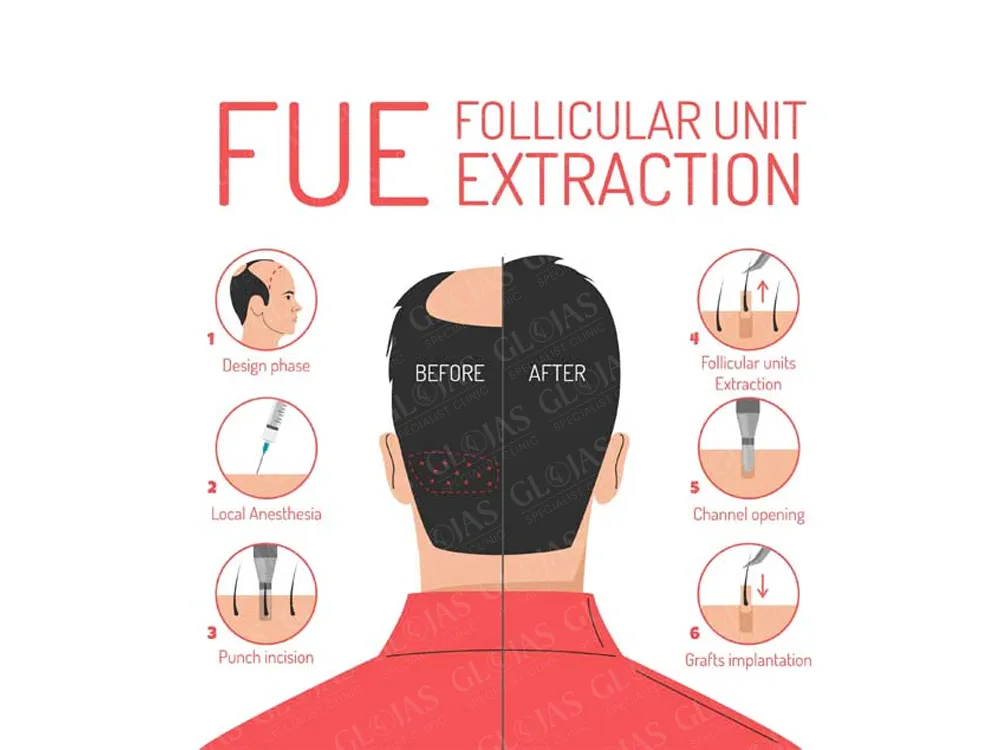
Hair loss can be a distressing experience for many individuals, impacting their confidence and self-esteem. As a solution, Follicular Unit Extraction (FUE) hair transplants have gained popularity due to their minimally invasive nature and natural-looking results. However, one of the most pressing questions prospective patients have is, “How long does a FUE hair transplant last?” This blog delves into the lifespan of FUE hair transplants, the factors influencing their longevity, and what patients can expect throughout the process. Understanding FUE Hair Transplantation Before discussing how long the results last, it’s essential to understand what FUE entails. FUE is a method of harvesting hair follicles from a donor site, typically the back of the scalp, and transplanting them into areas of thinning or balding. Unlike traditional strip harvesting methods, FUE involves extracting individual follicular units, which minimizes scarring and allows for quicker recovery. The FUE Process Consultation: The process begins with a thorough consultation where a qualified surgeon assesses the patient’s hair loss, discusses goals, and determines if FUE is the right option. Preparation: On the day of the procedure, the donor area is shaved, and local anesthesia is administered to ensure comfort. Harvesting: Individual hair follicles are extracted using a specialized tool. This step requires precision to ensure the health and viability of the follicles. Transplantation: The harvested follicles are then implanted into the recipient area. The surgeon carefully places each follicle at an angle and depth that mimics natural hair growth. Recovery: After the procedure, patients receive instructions on post-operative care, which is crucial for optimal results. Lifespan of a FUE Hair Transplant Initial Shedding Phase After a FUE hair transplant malaysia, it’s common for patients to experience a shedding phase, known as “shock loss.” This typically occurs 2-3 weeks after the procedure and can last several weeks. Although it can be alarming to see the newly transplanted hair fall out, this is a normal part of the hair growth cycle. The follicles enter a resting phase before new hair begins to grow. Timeline for Growth Typically, patients can expect to see new hair growth starting around 3-4 months post-transplant. Full results usually become evident within 9-12 months, with the hair reaching its maximum density and length. At this point, most patients are pleased with the outcomes, which can last for many years. Longevity of Results The longevity of results from a FUE hair transplant is often dependent on several factors: Hair Growth Cycles: Hair follicles undergo cycles of growth (anagen), rest (telogen), and shedding (catagen). Once transplanted, the hair follicles will follow the natural growth cycles of the body. The transplanted hair is usually permanent, as it is taken from areas resistant to balding. Donor Hair Quality: The health and quality of the donor hair significantly influence the longevity of results. Follicles harvested from dense and healthy areas tend to thrive better when transplanted. Patient’s Age and Genetics: Individual factors such as age, genetic predisposition to hair loss, and overall health can impact how well the transplanted hair lasts. Younger patients may have a more favorable outcome, while those with a strong family history of balding may experience further hair loss in non-transplanted areas. Post-Operative Care: Following post-operative care instructions diligently is crucial for achieving the best possible results. This includes avoiding strenuous activities, protecting the scalp from sun exposure, and adhering to prescribed medications. Lifestyle Factors: Factors such as diet, stress, smoking, and alcohol consumption can also influence hair health. A balanced diet rich in vitamins and minerals, particularly those known to promote hair growth (like biotin and zinc), can aid in maintaining the health of the transplanted hair. Do You Need Additional Treatments? While the transplanted hair is generally permanent, it is essential to recognize that hair loss can continue in untreated areas. Patients often inquire about additional treatments, such as: Medications: Minoxidil (Rogaine) and finasteride (Propecia) are common medications that can help prevent further hair loss and enhance hair growth. PRP Therapy: Platelet-rich plasma (PRP) therapy involves drawing a small amount of blood, processing it to concentrate the platelets, and injecting it into the scalp. This treatment may enhance the health of existing hair follicles and improve overall hair density. Follow-Up Transplants: Some patients may choose to undergo follow-up FUE procedures in the future to address thinning in other areas of the scalp as they age. Emotional Impact of FUE Hair Transplants The psychological benefits of FUE hair transplants should not be underestimated. Many patients report improved self-esteem and confidence post-procedure. The ability to have a fuller head of hair can positively impact personal and professional relationships, leading to a more fulfilling life. Preparing for Your Hair Transplant If you are considering a FUE hair transplant, it is crucial to choose a reputable clinic with experienced surgeons. Researching their qualifications, reviews, and past results can help ensure you make an informed decision. During the consultation, be open about your expectations and ask questions regarding the longevity of results, care, and potential risks. Conclusion In summary, a FUE hair transplant can offer long-lasting results, with transplanted hair often remaining permanent due to the nature of the follicles. While initial shedding may occur, new hair growth typically begins within a few months, with full results visible by the end of the first year. The longevity of the transplant results can be influenced by various factors, including the quality of donor hair, genetic predispositions, and post-operative care. By understanding these elements and following the recommended aftercare, patients can enjoy the benefits of their hair transplant for many years. If you’re considering a FUE hair transplant, consult a qualified professional to discuss your options and create a tailored plan that meets your needs. Frequently Asked Questions Q1: How long does it take to see results after a FUE hair transplant? A: After a FUE hair transplant, initial results typically start to become visible around 3-4 months post-procedure. However, full results, including maximum density and hair length, usually take about 9-12 months to achieve. During this time, you may
Transform Your Look with the Power of Hair Transplantation: 7 Surprising Benefits
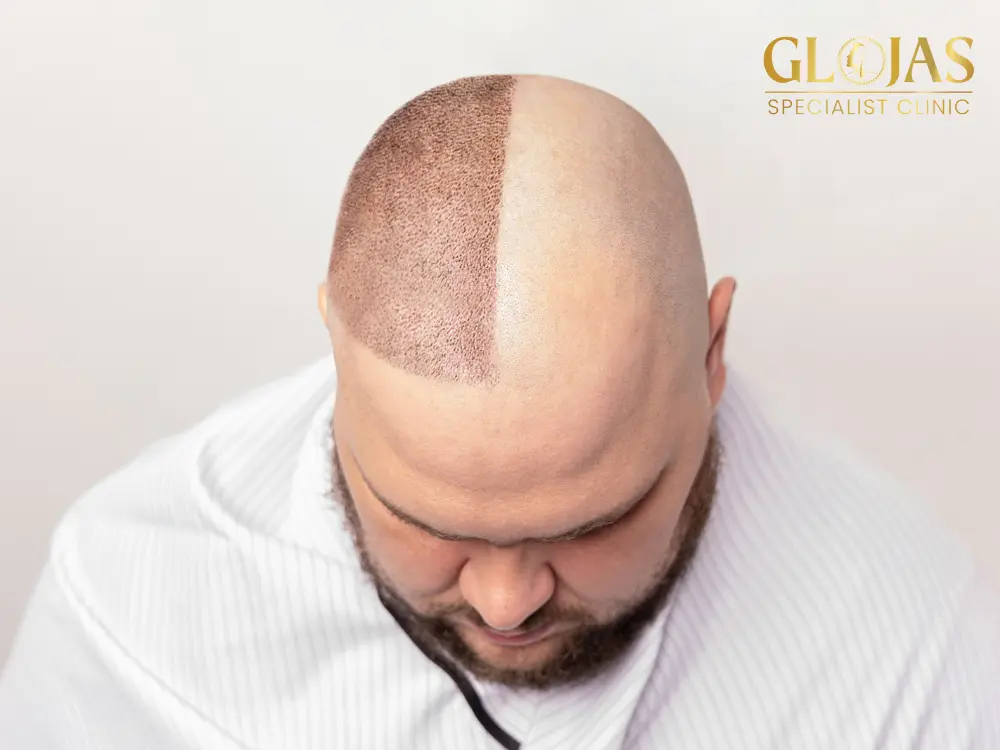
Hair loss can be a challenging experience, affecting both men and women across various ages. However, with the advancements in medical technology, hair transplantation has emerged as a powerful and effective solution to combat this issue. This article will delve into the intricacies of hair transplantation, highlighting its benefits, procedure, and everything you need to know before considering it. The video titled “Hair Transplant Before & After Transformation – IMMEDIATE Results with SMART™ FUE at Glojas Clinic” features a patient from Somalia who underwent the SMART™ FUE procedure for advanced male pattern hair loss. The patient had no hairline, and the hair loss extended to the mid-scalp. The video highlights the positive experience at Glojas Clinic, with the patient praising the professional staff and immediate results after the procedure. The treatment effectively restored his hairline, and the patient expressed gratitude for the transformation. Understanding Hair Transplantation Hair transplantation is a surgical procedure designed to restore hair in areas where hair loss has occurred. The process involves removing hair follicles from one part of the body, usually the back or sides of the scalp, and implanting them into the balding or thinning areas. This technique ensures that the transplanted hair blends naturally with your existing hair, providing a fuller and more youthful appearance. The Science Behind Hair Transplantation The success of hair transplantation lies in the science of follicular unit extraction (FUE) or follicular unit transplantation (FUT). In FUE, individual hair follicles are extracted and transplanted, while in FUT, a strip of scalp is removed, and the hair follicles are then harvested and implanted. Both techniques have their advantages, but FUE is generally preferred for its less invasive nature and quicker recovery time. Who Can Benefit from Hair Transplantation? Hair transplantation is suitable for individuals experiencing significant hair thinning or balding, particularly those who have not responded well to other treatments like medication or topical solutions. It is essential, however, to consult with a qualified surgeon to determine if you are a good candidate for the procedure, as factors like the extent of hair loss, hair type, and overall health play a critical role in the outcome. The 7 Surprising Benefits of Hair Transplantation 1. Natural-Looking Results One of the most significant advantages of hair transplantation is the natural-looking results it delivers. Since the procedure uses your own hair, the transplanted follicles grow naturally, matching your hair’s texture and color. The precision involved in placing each follicle ensures a seamless blend, making it virtually impossible to distinguish between transplanted and natural hair. 2. Permanent Solution Unlike temporary hair loss solutions like wigs or hairpieces, hair transplantation offers a permanent solution. Once the transplanted hair follicles establish themselves in the scalp, they continue to grow for a lifetime, eliminating the need for ongoing treatments or maintenance. 3. Improved Self-Esteem Hair loss can have a profound impact on one’s self-esteem and confidence. By restoring your hairline and filling in thinning areas, hair transplantation can significantly boost your self-image. The positive change in appearance often leads to a more confident demeanor, improving social and professional interactions. 4. Minimal Downtime Thanks to advancements in surgical techniques, hair transplantation procedures like FUE involve minimal downtime. Most patients can return to their normal activities within a few days, with full recovery expected within a couple of weeks. This quick recovery period is ideal for those with busy schedules. 5. Low Maintenance Once the transplanted hair begins to grow, it requires no special care or maintenance. You can treat it just like your natural hair—wash, cut, and style it as usual. This low-maintenance aspect makes hair transplantation an attractive option for those seeking a hassle-free solution. 6. Cost-Effective in the Long Run Although hair transplantation may have a higher upfront cost compared to other hair restoration methods, it is more cost-effective in the long run. The permanence of the results means you won’t need to invest in continuous treatments or replacements, saving you money over time. 7. Customized Treatment Plans Hair transplantation is not a one-size-fits-all solution. Surgeons can tailor the procedure to meet your specific needs, whether you require a small area filled in or a more extensive restoration. This customization ensures you achieve the best possible results, aligned with your goals and expectations. The Hair Transplantation Procedure: What to Expect Pre-Procedure Preparation Before undergoing hair transplantation, a thorough consultation with your surgeon is necessary. During this consultation, your surgeon will assess your hair loss pattern, discuss your expectations, and create a customized treatment plan. You may be advised to stop certain medications or follow specific guidelines in preparation for the surgery. The Surgical Process On the day of the procedure, you will be administered local anesthesia to numb the area. If you are undergoing FUE, individual hair follicles will be carefully extracted using a specialized tool. In the case of FUT, a strip of scalp will be removed, and the follicles will be harvested. The surgeon will then make tiny incisions in the recipient area, where the follicles will be implanted. Post-Procedure Care After the surgery, you will receive detailed instructions on how to care for your scalp and transplanted hair. It is normal to experience some redness, swelling, or minor discomfort, which typically subsides within a few days. It is crucial to follow your surgeon’s aftercare guidelines to ensure optimal healing and prevent complications. Hair Transplantation Recovery and Results Short-Term Recovery The initial recovery phase involves some redness and scabbing in the treated area, but this should resolve within a week. You may notice shedding of the transplanted hair within the first few weeks—this is a normal part of the process as the follicles enter a resting phase before starting new growth. Long-Term Results Hair growth from the transplanted follicles typically begins around three to four months post-surgery, with noticeable improvements by six to twelve months. The final results are usually evident within a year, revealing a fuller, more natural-looking head of hair. Potential Risks and Considerations While hair transplantation is generally safe and
